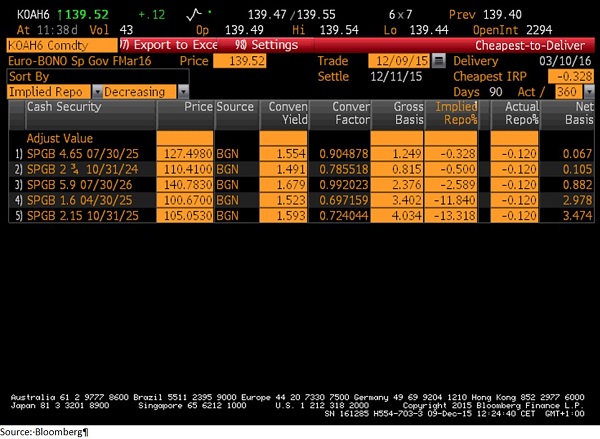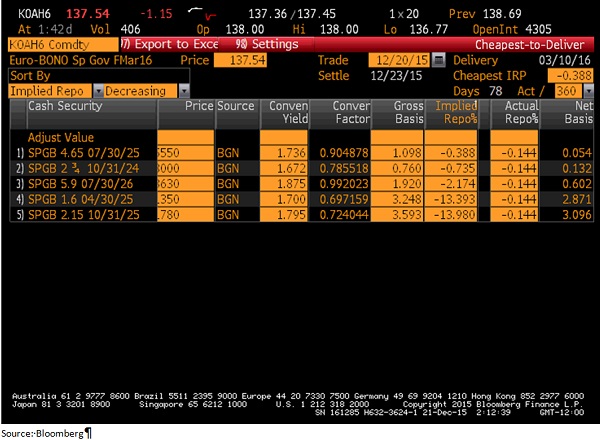Jan 06, 2016
Eurex
Using Euro-BONO Futures to hedge Spanish yield risk
This article will demonstrate how an investor with exposure to Spanish government debt can hedge against yield changes using Eurex Euro-BONO Futures (Product ID: FBON):
- In the first example, the cheapest-to-deliver (CTD) bond will be hedged,
- whereas in the second we will demonstrate how a non-CTD Spanish bond can be hedged with Euro-BONO Futures.
The examples also show the effectiveness of the Eurex Euro-BONO Futures at a time when the Spanish yields were in focus due to the Spanish elections on 20 December 2015.
On 9 December 2015, the deliverable basket for the March 2016 Euro-BONO Futures contract on Eurex Exchange was the following:

The cheapest-to-deliver is the deliverable bond with the highest implied repo rate that an investor with a short futures position can deliver at maturity. The cheapest-to-deliver bond for this contract on 9 December 2015 was the Spanish government bond (SPGB) with a coupon of 4.65 and maturity on 30 July 2025. The relationship between the cash bond price and the futures price is given by the following equation:
Changes in current bond price = Conversion factor x Changes in current futures price
It is generally assumed that the price of the CTD bond governs the behaviour of the futures contract, therefore the two prices are highly correlated. The conversion factor is a number that is used in bond hedging in order to adjust the value of a deliverable bond to the value that it would have had if the yield were 6% (the notional coupon of the futures contract standard).
Example 1: Hedging the CTD
Hedge EUR 4 million of SPGB 4.65% 30-Jul-2025 with March 2016 Euro-BONO Futures.
The SPGB 4.65% Jul-2025 has a conversion factor of 0.904878 and a modified duration of 7.969. As shown in the Bloomberg screenshot above its yield to maturity (YTM) is 1.554%. In order to find the number of contracts needed for hedging, the hedge ratio needs to be calculated. The formula is the following:
Hedge ratio =
Cash bond position MD of the bond portfolio
_______________ x ___________________ x Conversion factor
Price of CTD x 1,000 MD of CTD
This is known as the modified duration (MD) method for finding the hedge ratio. The modified duration represents the percentage change in price for a 1% change in yield. On 9 December 2015 (at the time of transaction) the variables had the following values:
Cash bond position | 4,000,000 |
Price of CTD | 127.49 |
MD of bond portfolio | 7.9690 |
MD of CTD | 7.9690 |
Conversion factor of CTD | 0.904878 |
By applying the hedge ratio formula, we found that the number of contracts that we need to short is 28. The price of the FBON March 2016 contract at the time of the transaction was 139.52 EUR. Therefore, the market value of the position we take in the futures was:
139.52 x 28 contracts x 1,000 = EUR 3,906,560
We also calculated the basis point value (BPV) of the cash bond portfolio, as that number would help us find the change in value of the portfolio. The basis point value is, essentially, the change in the value of the position for a change on 1 basis point (0.01% or 0.0001) in the yield to maturity of the bond position. It is calculated as:
BPV = cash bond position x MD of bond portfolio x 0.0001
= 4,000,000 x 7.9690 x 0.0001 = 3,187.6 EUR
Now let’s take a look at how the hedge worked after the Spanish general elections on 20 December 2015. Below we can see the deliverable basket for the FBON March 2016 on 21 December 2015:

The change in value of the futures position was calculated as follows (using the same methodology as earlier):
Futures position on 21 December 2015 | |
FBON Mar16 price | 137.54 |
New value of futures position | 3,851,120 (= 137.54 x 28 x 1,000) |
Change in value | 55,440 EUR (= 3,851,120 - 3,906,560) |
This means that we have made a profit of EUR 55,440 on our futures position. Next, we needed to calculate the change in value of our cash bond position. The yield to maturity (YTM) of the CTD was now 1.736%, which is a change of 0.182% or 18.20 basis points from the initial YTM. The change in value of the cash bond position, therefore, is:
Change in cash bond position
= basis point change x basis point value of cash bond position
= 18.20 x 3,187.6 = EUR 58,014
This is a loss due to the decrease in price of the CTD bond. Taking the total of our cash and futures position, the result is:
Profit from futures position | 55,440 |
Loss from cash bond position | -58,014 |
P&L | -2,574 |
In other words, the profit from the Euro-BONO Futures position almost offset completely the loss from the cash position.
At this point it is good to mention that the example assumes no change in the deliverable bond for the duration of the hedge. In reality, it is possible that the CTD bond changes, in which case the hedge needs to be readjusted (contracts need to be bought/sold accordingly). This process is referred to as dynamic hedging.
Example 2: Hedging the non-CTD
Hedge EUR 6.5 million of SPGB 1.6% 30-Apr-2025 with March 2016 Euro-BONO Futures.
The SPGB 1.6% Apr-2025 has a modified duration of 8.574. This means that if the yield changes 1% then the bond price would change by 8.574% of its nominal value. Its YTM is 1.523% on 9 December 2015. Following the same methodology as in the first example, we found the hedge ratio:
Value of portfolio | 6,500,000 |
Price of CTD | 127.49 |
MD of bond portfolio | 8.574 |
MD of CTD | 7.969 |
Conversion factor of CTD | 0.904878 |
Hedge ratio | 50 |
This means that 50 contracts needed to be shorted to hedge our position in the non-CTD bond. The market value of our futures position in this case would be 6,976,000 EUR (= 139.52 EUR the futures price x 50 contracts x 1,000).
The BPV of this portfolio was 5,573 (= 6,500,000 x 8.574 x 0.0001).
After the Spanish elections, the change in the value of the futures position was:
Futures position on 21 December 2015 | |
FBON Mar16 price | 137.54 |
New value of futures position | 6,877,000 (= 137.54 * 50 * 1,000) |
Change in value | 99,000 EUR (= 6,976,000 – 6,877,000) |
The change in value of the futures again represents a profit since we were short futures. The YTM of the non-CTD bond changed to 1.70%, which is a change of 0.1770% or 17.70 basis points. Similarly to the previous case, the change in value of the cash bond position in the non-CTD was:
17.70 x 5,573.1 = 98,644 EUR.
Taking the total positions, we had:
Profit from futures position | 99,000 |
Loss from cash bond position | -98,644 |
P&L | -356 |
Again, the position in the Euro-BONO Futures protected our portfolio from large losses that we would have otherwise incurred due to the increase in Spanish yields.
Please note, that these examples follow the academic approach of using modified duration to calculate the hedge ratio. Another popular alternative amongst practitioners is to use the DV01 approach, which might result to a slightly different hedge ratio (and consequently P&L).
Authors:
Vassily Pascalis, Senior Vice President, Eurex Business Development
Antonios Tsiantas, Associate, Eurex Business Development
